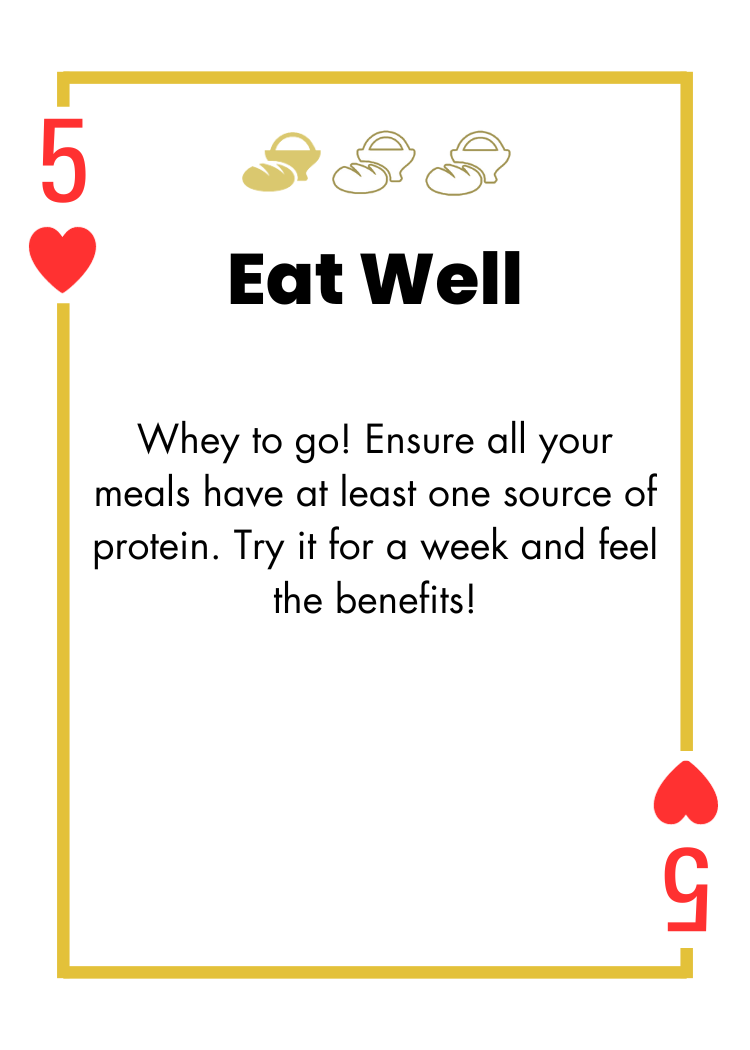5 of Hearts - Whey to Go

Protein is one of the four key macronutrients of a healthy diet, but which one is the best for you? Whether it’s meat or an alternative, each food has different nutritional benefits for the body, as well as different costs and cooking preparation.
Our expert nutrition coaches can help you make the best choices for you and your family, customising their support to your needs, not just a cookie-cutter approach. Book an appointment today and speak to them online from home, from work, or even from the supermarket!

Protein is accessible in a range of dietary sources. These sources include foods of animal and plant origins along with the sport supplement industry sources which include whey, casein, and soy (Hoffman and Falvo 2004). Animal sources of protein include foods like meat, fish, eggs, and dairy. Plant sources of protein include whole grains such as oats or quinoa, nuts & seeds such as almonds and legumes such as soy or beans.
Recommended Daily Intake of Protein for Adult Males and Females
| Age | Recommended Daily Intake of Protein (Grams per day) | |
|---|---|---|
| Men | Women | |
| 19-70 | 64 g/day | 46 g/day |
| 70 Plus | 81 g/day | 57 g/day |
Note: Table adapted from Nutrient Reference Values for Australia and New Zealand on https://www.eatforhealth.gov.au/nutrient-reference-values/nutrients/protein
Protein can act as a source of energy but its main function in the body is growth, repair, and maintenance. Protein is a vital building block required in the human body. It helps to form and maintain muscles, hair, nails, skin, and major organs like the heart, kidneys, and liver. People all contain a significant amount of protein in their bodies (Nutrition Foundation NZ 2022).
Proteins are nitrogen-containing substances formed by smaller building blocks called amino acids. Proteins then serve as the larger structural component of muscle and other various tissues in the body. In addition, they are also used to produce hormones, enzymes, and haemoglobin. Proteins can be utilized as a source of energy in the body, but they are not the primary choice as an energy source. For proteins to be used by the body they need to be metabolized back into their simplest form as amino acids (Hoffman and Falvo 2004).
Protein is composed of 20 types of amino acids. While all 20 of these are important for your health, nine are classified as essential amino acids which cannot be synthesized by the body so they must be obtained from foods in our diet while the other eleven are non-essential amino acids which can be produced by our body (Nutrition Foundation NZ 2022).
Small changes CAN make a big difference – that’s what the 1% club is all about
Protein. NZ Nutrition Foundation. (2022, June 22). https://nutritionfoundation.org.nz/nutrition-facts/Nutrients/protein/
National Health and Medical Research Council. (2021, April 12). Protein. Protein | Eat For Health. https://www.eatforhealth.gov.au/nutrient-reference-values/nutrients/protein
Hoffman, J. R., and Falvo, M. J. (2004). Protein – Which is Best?. Journal of sports science & medicine, 3(3), 118–130.


 See Other Cards!
See Other Cards!